Being Inspired, Part 1
Welcome to Inspired Week. The theme of the week is the new inspired mechanic from Born of the Gods, but as I have already written an article about how the inspired mechanic was designed, I thought I'd venture down a slightly different take on this week's theme. You see, I am asked all the time where my, and my fellow designers', inspiration comes from. For today's column (and next week's) I thought I'd start with Theros and work my way back through every block Magic has ever done to tell you what inspired it. I hope that sounds fun.
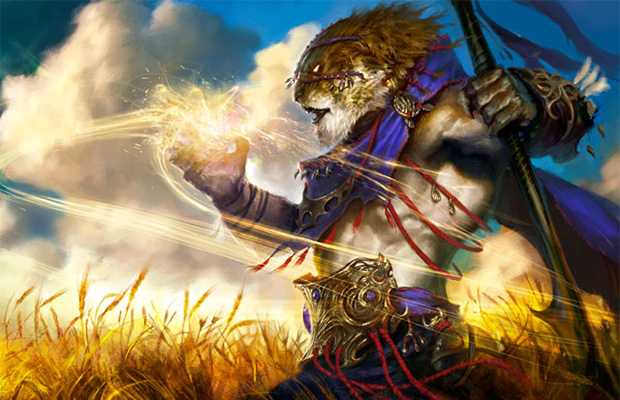
Oreskos Sun Guide | Art by Mathias Kollros
- 1% Inspiration
Before I jump in and explain the inspiration for each block, let me first talk about why it's important that each block has a different inspiration. Magic, at its core, is a game about change. I like to think of it as a living, breathing thing that is constantly evolving. If we kept doing the same thing, the game would grow stagnant and our playerbase would get bored. This means that one of the responsibilities of Ramp;D is to keep coming up with new ways to play the game. The best way to do this is by creating new blocks that take the game in new directions.
But there is a big obstacle to creative thinking—the neurology of the human brain. You see, our brain is a pretty complex organ that does an incredible amount of work. In order to maximize that work, the brain takes short cuts whenever it can. It will look at how we did something the last time and copy that. The brain starts making neural pathways that grow with time.
Now, in a vacuum, this makes sense. Let's say you want to use, well, a vacuum, to clean up. Odds are the way you used it the last fifty times you used the vacuum will work just fine for the fifty-first time. (I'm well aware that numerous readers have never used a vacuum fifty-one times, but I have kids, and for those who don't, here's a foreshadowing—they're very, very messy.) The brain's shortcutting, most of the time, is a blessing, because it allows us to do what we want without any excess brain activity.
But when it comes to creative endeavors, doing it the way you did it last time is not exactly a blessing. In fact, have you ever tried to solve a problem and you kept coming up with the same solutions? That's your brain using the same worn neural pathways. How do you solve this issue? By approaching your problem from a different vantage point. (My article "Connect the Dots" goes deep into the topic of creative thinking if you're interested.) By forcing yourself to think about it in a different context, you make your brain create new neural pathways that will lead to new answers. This is why, when I'm stuck in the design of a card (or mechanic or theme), I sometimes will create a self-imposed restriction to force me to think differently. (I am now obligated to state "Restrictions breed creativity.")
The reason we want each block to have its own inspiration is that we want to approach each block differently, so the people working on it approach it from a direction no design team has approached it before.
My last note before I jump into the blocks is that I am going to talk about where we started for each design, not necessarily where it ended up. As you will see, some blocks started one place and ended up someplace different. This leads to another important creativity lesson: don't let where you once were keep you from going where you need to be. A jumping-off point is just a place to get started. If your creative work moves away from it, do not be afraid to follow it.
With all that out of the way, let's start talking inspiration.
- Theros Block
This block's design started with a simple idea—let's do a top-down set inspired by Greek and Roman mythology that has an enchantment component. Why was it important that it had an enchantment component? Why couldn't we have just started with "top-down Greek and Roman mythology-inspired set?" I think we knew that Greek and Roman mythology was going to be tougher than the horror theme of Innistrad,which at the time was our one successful top-down block, because it had fewer elements that clearly tied to game mechanics.
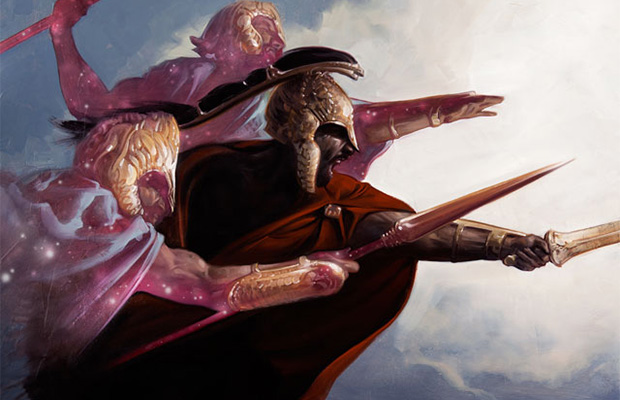
God Favored General | Art by David Palumbo
Also, as much as I love top-down creative-inspired design, it's always important when starting a design to have some inkling of what mechanical elements you might want to work with. If you don't have any mechanical ideas, you'll find that your first set of commons won't have the cohesion you need to make the set play well together.
Finally, while we always knew we would be selling the set on Greek mythology (the Roman part got pulled out early in design), it's important that there are elements of the set you can stress for the audience that isn't excited by the creative elements. "Yeah, yeah, Greek mythology, what's this set doing new, mechanically?"
- Return to Ravnica Block
This block is actually one of the trickiest ones we've done. Ravnica block was very popular, perhaps the most popular block of all time, so we wanted to make sure we captured enough of what made it popular the first time. The problem was, we needed to have a different vantage point to not run into the problem I explained above. It had to be, as is often joked about in Hollywood, "the same but different."
The block ended up with two things that drove the inspiration:
- The block structure: This was very different than the first Ravnica block. Rather than Large/Small/Small with a 4/3/3 guild breakdown, Return to Ravnica was Large/Large/Small with a 5/5/10 guild breakdown. Also, Gatecrash was drafted without Return to Ravnica when it first came out. Adapting the set to this structure required the design teams to approach the sets very differently.
- The guild identities: While the original Ravnica block got a lot right, it made some mistakes and made some choices dictated by the environment of the time. We had been forced to do Azorius differently than it naturally wanted. Simic had a creative take that also deviated from where the guild naturally wanted. There were some mechanics like radiance that weren't a great fit for their guild. What this meant was that Return to Ravnica block was seen as a chance for us to get right some of the things we did not the first time around.
These two things were enough to give the design a different vantage point for inspiration.
- Innistrad Block
On the surface, this block's inspiration might seem simple—make a top-down set inspired by the horror genre. The reality, though, was a little different. My main inspiration was not "do a horror set" but "prove a top-down set can be done properly." As I'll talk about when I get to it, Champions of Kamigawa block was our first top-down design, but it had problems that, for years, scared us away from doing other top-down designs.
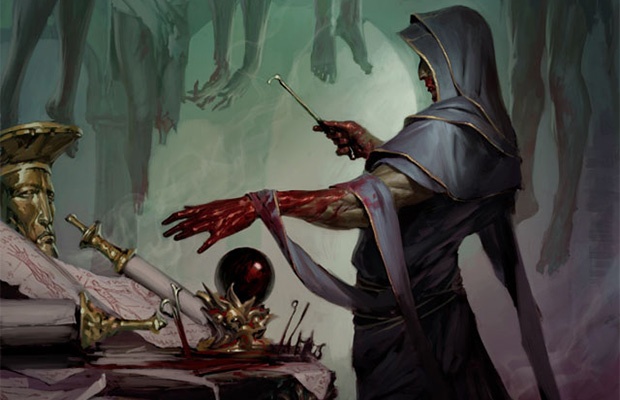
Pain Seer | Art by Tyler Jacobson
My early inspirations stemmed from trying to explore how best to tackle a top-down design. How would I interact with the creative team to make sure that the mechanics lined up with the flavor? How could I be true to the source material but accomplish the requirements of the design, such as color balance? How did I get cards that felt right but allowed the set to still have an overall mechanical connection?
All that said, a lot of where the cards and mechanics came from was direct inspiration of the source material. I spent a lot of time making Zombies feel like zombies and Werewolves feel like werewolves and Vampires feel like vampires.
I was very happy that both points of inspiration got properly handled.
- Scars of Mirrodin Block
This block's inspiration was reintroducing the Phyrexians. They had been Magic's major villains for most of the early days but had been killed off at the end of the Weatherlight Saga story during the Invasion block. When we had built Mirrodin, the creative team planted the seeds for the Phyrexians' return and the original plan for this block was to come back to New Phyrexia. The original plan was that later in the block we were going to make the big reveal—this used to be Mirrodin! (Duh, duh, duh!)
When I started this block's design, my goal was to find cards and mechanics that could embody the Phyrexians and their philosophy during game play. I didn't just want the block to be about the Phyrexians, I wanted the sets themselves to reflect the Phyrexians, to feel Phyrexian. It wasn't until many months into design of Scars of Mirrodin that the idea of ending the block with the Phyrexians turning Mirrodin into New Phyrexia.
And remember that the reveal of this being Mirrodin was supposed to happen later in the block, so my goal with the set was to have subtle references to Mirrodin so when the truth came out you could look back and go "Of course, how did I not see that?" but not do things that directly drew attention to the Mirran qualities of the world.
We later changed so we could start the story on Mirrodin before the shift to New Phyrexia, and that is when we brought in the part of the design that reflected modern-day Mirrodin.
- Zendikar Block
For as flavorful as this block ended up, it actually started at the opposite end of the spectrum. When I first pitched this block to my boss, at the time Randy Buehler, I explained that I thought there was a vein of design space involving lands and I wanted this block to be an experimental one where I played around with what we could do. Adventure World, the Eldrazi, the hedrons—that all came later. The first couple months of Zendikar design was trying out new land mechanics.
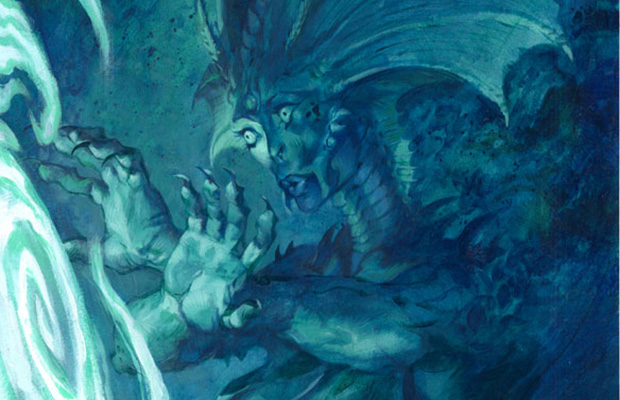
Deepwater Hypnotist | Art by Christopher Moeller
I should mention at this point that I believe one of the keys to changing up how we approach blocks is to shift the methods we start with. I like that some blocks have a more creative start while others have more of a mechanical one. The integration with the creative team has gotten so good that I know we'll find a clean connection between mechanics and flavor no matter which part we start with.
It's also interesting to note how we got to Adventure World. The land mechanics ended up focusing on lands and mana, which led creative to explore why a world would be rich in mana, which led them to the idea of Planeswalker fortune hunters who come to the plane looking for "treasure." This led them to an Adventure World where the world itself was dangerous. This forced them to figure out why it was so dangerous, which led to the creation of the Eldrazi.
Zendikar design was essentially broken into two parts. The first part, the mechanical center of the set, led to landfall and kicker, and the second, which was then addressing the creative treatment that created allies, traps, and quests.
- Shards of Alara Block
This block started out as a designated multicolor block that wasn't Invasion and wasn't Ravnica. Because Invasion had done five-color and Ravnica had done two-color, Bill Rose, the lead designer of Shards of Alara and Conflux, was interested in trying three-color. But Bill actually had a bit of inspiration beyond that. Bill was interested in the idea of an all-gold expansion. After some thought, Bill realized that it had to be the third set in a Large/Small/Small block. The reason was simple. The block would have to build up to an environment that could handle it.
I talked above about blocks that started in one place but shifted focus as the design evolved. When Bill started there were no shards. The early design wasn't about creating three-color identity but rather making an environment where three-color would be played. The creative team, led by then-Creative Director Brady Dommermuth, came up with the shards with a way to explain the three-color focus. The shards would later take on a life of their own and guide design. (This is similar to how Ravnica block evolved, as I'll explain below.) This led to the creation of shard design teams that focused solely on their one-fifth of the set.
I want to point out that multicolor has proven to be a tough theme for us. It is wildly popular, so we want to keep doing it, but it has so many structural demands because of both the mana requirements and the inflexibility of color balance (each time you make a multicolor card, you're kind of obligated to make one of every other faction you're focusing on).
- Lorwyn/Shadowmoor Block
This block was inspired by, of all things, Coldsnap. Say what? Two years earlier, Ramp;D was asked what we would do if we made a fourth expansion for the year. We brainstormed a bunch of ideas and end up with the concept of finding a lost Magic set, specifically the missing third set of the Ice Age block. When the dust settled, I wasn't very happy with how Coldsnap turned out. I said to Bill at the time, "The next time we do a fourth set can you come to me before we've designed the block? I think I can make us something that feels more organic."
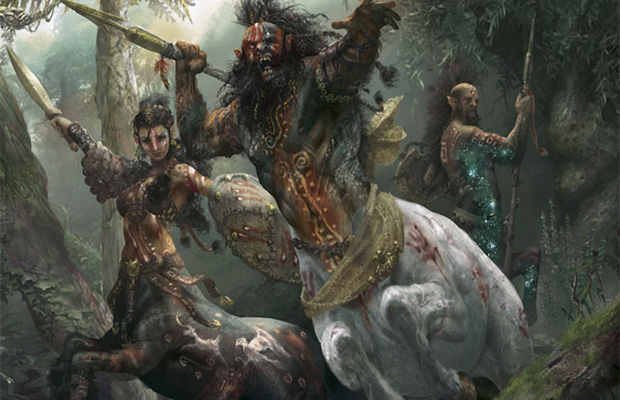
Pheres-Band Raiders | Art by Ryan Barger
Not too much later, Bill came to me and said, "Okay Mark, we're doing another year with a fourth set. Do your magic."
Yes, the inspiration for this block was the block structure. How could I do four sets in a way that felt natural? I wanted the fourth set to feel like something that had to be there rather than something that felt as tacked on as Coldsnap. It was me examining this problem that caused me to come up with the idea of two mini-blocks, each with one large and one small set.
The idea was that these two blocks would be connected flavorfully and mechanically but function as two different blocks. The fall set had tentatively been tagged as a tribal set, so I worked to find a second theme that could work with it. Once I stumbled upon hybrid, I felt I had enough to start with. I liked that Shadowmoor would have tribes that Lorwyn would care about (they would later change in Shadowmoor block more than I was happy with) and Lorwyn cards would be colored to work with the "color matters" theme of Shadowmoor.
The flavor of Lorwyn came about for two reasons. One, the idea of two worlds where one was the shadow of the other led the creative team to make the first world shiny and bright for contrast. Two, the creature types we selected, based partly on what we thought would be enjoyed by the fans for the next tribal block, pushed us toward a fairy tale feel. Shadowmoor's creative design was being the dark shadow of what had been done in Lorwyn.
The concept of the shift of worlds also led me to the idea of creature types that shifted color over the course of the two mini-blocks. The idea at the time was that Shadowmoor would enable some new types of tribal decks because the color shifting made new combinations possible. With 20/20 hindsight, I wished we had shifted from two-color in Lorwyn to three-color in Shadowmoor, so while we added something we also made more cards that slid straight into your Lorwyn tribal decks.
- Time Spiral Block
Of all the blocks I'm talking about today (I'll talk about Magic's first ten blocks next week), this is the one that had the greatest shift from where it began to where it ended up. Time Spiral block started up with me wanting to make use of a mechanic that the Saviors of Kamigawa design team had come up with—suspend. This pushed me toward the idea of a block built around a time theme. I found our second mechanic in Coldsnap design and asked for it to be pushed off to Time Spiral. The third time mechanic was flash, an ability that the game had had for a long time but was then keyworded.
The idea of a time theme led me to the past/present/future breakdown for the block plan (how else do you divide time in three?). While trying to figure out how to convey past, we found ourselves looking at cards from Magic's past, and that started a nostalgia snowball that would just keep growing in size. Eventually, the nostalgia theme would pull the focus from the time theme (which was still there).
While there are many things I might change about Time Spiral if I were doing it today, I did enjoy the process of discovery that the design went through. Some of my favorite designs came about because during the design process we took a sharp left turn and ended up somewhere I never would have predicted when we began.
- Ravnica Block
This block started out much like Shards of Alara block—don't be like the multicolor block we had previously done. The last multicolor block was Invasion and it had a strong "play as many colors as possible" theme. As I was trying to be multicolor without being Invasion, I went in the opposite direction. What was the fewest colors you could play but still be multicolor? And that is how I got to a two-color theme.
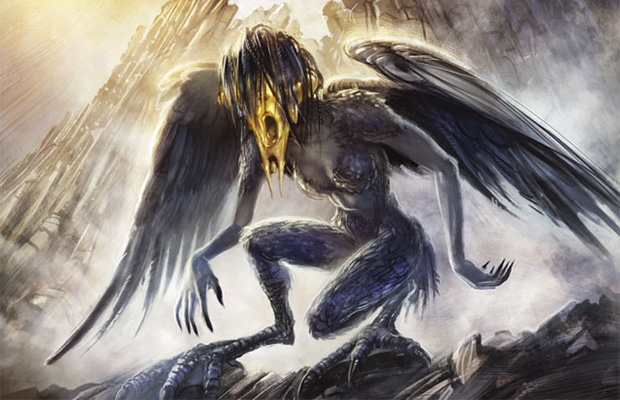
Siren of the Silent Song | Art by Anthony Palumbo
The next step I took was to put all ten-color pairs on equal footing. This block would not differentiate between ally- and enemy-color pairs. I then took this idea to the creative team and Brady Dommermuth made the great breakthrough of the guilds. I liked the idea as soon as he told it to me so I shifted the design to maximize the guilds. That led me to the 4/3/3 model and the rest was history.
This is another block where I started with a theme for inspiration and as I dug deeper it resulted in more things that inspired me. For instance, I am not sure I could ever have gotten to the idea of doing a set where only some of the two-color pairings appeared in it without first having the idea of the guilds. Ravnica, by the way, is a great example of what awesome things can happen when design and creative can riff off of one another.
- Ten To Go
I'm halfway done and I've hit my word count, so that means this journey of inspiration will have to continue next week. I hope you enjoyed my peek into the blocks of Magic's second decade and hope you'll likewise enjoy the stories of the first. As you can see, over the years, many different things have led to our designs.
As always, if you have any comments, please write me an email, make a comment in the thread to this article or contact me through any of my social media (Twitter, Tumblr, Google+, and Instagram).
Join me next week for more inspiration stories.
Until then, may you be likewise inspired to create something.
- "Drive to Work #94—Invitational, Part 3"
In today's first podcast, I continue my series on the history of the Invitational, talking about the ones in Sydney and Capetown won by the two best Magic players in history—Jon Finkel and Kai Budde.
- "Drive to Work #95—Emotional Connection"
In today's second podcast, I talk about a design topic near and dear to my heart: the importance of an emotional connection between the game and the players. If you enjoy my high-end design philosophy, this podcast is for you.
Multi |
- Episode 95: Emotional Connection (13.2 MB)
- Episode 94: Invitational, Part 3 (16.5 MB)
- Episode 93: Top Down Design (14.1 MB)
- Episode 92: Mailbag with Matt #1 (15.8 MB)
- Episode 91: Names (19.2 MB)
- Complete Drive To Work Podcast Archive



@maro254
Email Mark
Author Archive
Making Magic Archive
Working for Magic Ramp;D since October, 1995, Mark Rosewater is currently the head designer. His hobbies include spending time with his family, talking about Magic on every known medium (including a daily blog and a weekly podcast), and writing about himself in the third person.





